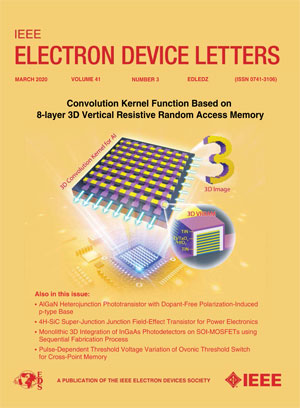p-GaN/AlGaN/GaN hemt栅极可靠性的增强
IF 4.5
2区 工程技术
Q2 ENGINEERING, ELECTRICAL & ELECTRONIC
引用次数: 0
摘要
这封信极大地提高了对正常off GaN hemt的理解,p-GaN栅极在正向栅极应力下的退化,并证明了在栅极端通过孔注入的高偏置情况下可以获得显著的可靠性增强。关键结果是:(i)我们首次采用了一种实验装置,能够在宽时间窗口(从$\mu $ s到失效)中研究器件在时间相关击穿测试期间的阈值电压位移。(ii)值得注意的是,我们证明了栅极击穿的加速因子在高应力电压下大大降低。(iii)高电压下较低的退化加速因子与注入和困在栅极堆中的孔数有关。结果提供了强有力的实验证据,证明从p-GaN接触中注入空穴可以通过重组减少导致降解的热电子的数量,从而对器件的鲁棒性产生有益的影响。本文章由计算机程序翻译,如有差异,请以英文原文为准。
Enhanced Gate Reliability of p-GaN/AlGaN/GaN HEMTs Due to Gate Hole Injection and Recombination
This letter substantially improves the understanding on the degradation of normally-OFF GaN HEMTs with p-GaN gate subject to forward gate stress, and demonstrates that a significant reliability enhancement can be obtained at high bias through hole injection from the gate terminal. Key results are: (i) for the first time we adopt an experimental setup capable of investigating the threshold voltage shift of the devices during time-dependent breakdown tests in a wide time window (from $\mu $ s to failure). (ii) Remarkably, we demonstrate that the acceleration factor for gate breakdown is substantially lower at high stress voltage. (iii) The lower acceleration factor of degradation at high voltages is correlated to the number of holes which are injected and trapped in the gate stack. The results give strong experimental evidence that the injection of holes from the p-GaN contact can have a beneficial effect on device robustness, by reducing – through recombination – the amount of hot electrons responsible for degradation.
求助全文
通过发布文献求助,成功后即可免费获取论文全文。
去求助
来源期刊

IEEE Electron Device Letters
工程技术-工程:电子与电气
CiteScore
8.20
自引率
10.20%
发文量
551
审稿时长
1.4 months
期刊介绍:
IEEE Electron Device Letters publishes original and significant contributions relating to the theory, modeling, design, performance and reliability of electron and ion integrated circuit devices and interconnects, involving insulators, metals, organic materials, micro-plasmas, semiconductors, quantum-effect structures, vacuum devices, and emerging materials with applications in bioelectronics, biomedical electronics, computation, communications, displays, microelectromechanics, imaging, micro-actuators, nanoelectronics, optoelectronics, photovoltaics, power ICs and micro-sensors.
 求助内容:
求助内容: 应助结果提醒方式:
应助结果提醒方式:


